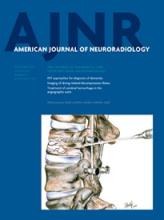Research ArticleNeurointervention
Contrast-Enhanced Time-Resolved MRA for Follow-Up of Intracranial Aneurysms Treated with the Pipeline Embolization Device
S.R. Boddu, F.C. Tong, S. Dehkharghani, J.E. Dion and A.M. Saindane
American Journal of Neuroradiology November 2014, 35 (11) 2112-2118; DOI: https://doi.org/10.3174/ajnr.A4008
S.R. Boddu
aFrom the Departments of Radiology and Imaging Sciences (S.R.B., F.C.T., S.D., J.E.D., A.M.S.)
F.C. Tong
aFrom the Departments of Radiology and Imaging Sciences (S.R.B., F.C.T., S.D., J.E.D., A.M.S.)
bNeurological Surgery (F.C.T., J.E.D.), Emory University School of Medicine, Atlanta, Georgia.
S. Dehkharghani
aFrom the Departments of Radiology and Imaging Sciences (S.R.B., F.C.T., S.D., J.E.D., A.M.S.)
J.E. Dion
aFrom the Departments of Radiology and Imaging Sciences (S.R.B., F.C.T., S.D., J.E.D., A.M.S.)
bNeurological Surgery (F.C.T., J.E.D.), Emory University School of Medicine, Atlanta, Georgia.
A.M. Saindane
aFrom the Departments of Radiology and Imaging Sciences (S.R.B., F.C.T., S.D., J.E.D., A.M.S.)

References
- 1.↵
- Molyneux AJ,
- Kerr RSC,
- Birks J, et al
- 2.↵
- Fiorella D,
- Kelly ME,
- Turner R, et al
- 3.↵
- Kallmes DF,
- Ding YH,
- Dai D, et al
- 4.↵
- Becske T,
- Kallmes DF,
- Saatci I, et al
- 5.↵
- Delgado Almandoz JE,
- Crandall BM,
- Fease JL, et al
- 6.↵
- Kaufmann TJ,
- Huston J 3rd.,
- Mandrekar JN, et al
- 7.↵
- 8.↵
- Blackham KA,
- Passalacqua MA,
- Sandhu GS, et al
- 9.↵
- Cashen TA,
- Carr JC,
- Shin W, et al
- 10.↵
- Farb RI,
- Agid R,
- Willinsky RA, et al
- 11.↵
- 12.↵
- Kwee TC,
- Kwee RM
- 13.↵
- 14.↵
- Wang Y,
- Truong TN,
- Yen C, et al
- 15.↵
- Fiorella D,
- Albuquerque FC,
- Deshmukh VR, et al
- 16.↵
- Siddiqui MA,
- Bhattacharya J,
- Lindsay KW, et al
- 17.↵
- Jabbour P,
- Chalouhi N,
- Tjoumakaris S, et al
- 18.↵
- Majoie CB,
- Sprengers ME,
- van Rooij WJ, et al
- 19.↵
- Wallace RC,
- Karis JP,
- Partovi S, et al
- 20.↵
- Byrne J,
- Szikora I
- 21.↵
- Kaufmann TJ,
- Kallmes DF
- 22.↵
- 23.↵
- Lettau M,
- Sauer A,
- Heiland S, et al
In this issue
American Journal of Neuroradiology
Vol. 35, Issue 11
1 Nov 2014
Advertisement
S.R. Boddu, F.C. Tong, S. Dehkharghani, J.E. Dion, A.M. Saindane
Contrast-Enhanced Time-Resolved MRA for Follow-Up of Intracranial Aneurysms Treated with the Pipeline Embolization Device
American Journal of Neuroradiology Nov 2014, 35 (11) 2112-2118; DOI: 10.3174/ajnr.A4008
0 Responses
Jump to section
Related Articles
- No related articles found.
Cited By...
- Visualization of Intracranial Aneurysms Treated with Woven EndoBridge Devices Using Ultrashort TE MR Imaging
- Differential Subsampling with Cartesian Ordering-MRA for Classifying Residual Treated Aneurysms
- Follow-up of Intracranial Aneurysms Treated by Flow Diverters: Evaluation of Parent Artery Patency Using 3D-T1 Gradient Recalled-Echo Imaging with 2-Point Dixon in Combination with 3D-TOF-MRA with Compressed Sensing
- Outcome Study of the Pipeline Embolization Device with Shield Technology in Unruptured Aneurysms (PEDSU)
- MRA versus DSA for the follow-up imaging of intracranial aneurysms treated using endovascular techniques: a meta-analysis
- Usefulness of Silent MR Angiography for Intracranial Aneurysms Treated with a Flow-Diverter Device
- Aneurysm Remnants after Flow Diversion: Clinical and Angiographic Outcomes
- Predictors of Incomplete Occlusion following Pipeline Embolization of Intracranial Aneurysms: Is It Less Effective in Older Patients?
- Non-Contrast-Enhanced Silent Scan MR Angiography of Intracranial Anterior Circulation Aneurysms Treated with a Low-Profile Visualized Intraluminal Support Device
- Imaging Follow-Up of Intracranial Aneurysms Treated by Endovascular Means: Why, When, and How?
- Silk Flow-Diverter Stent for the Treatment of Intracranial Aneurysms: A Series of 58 Patients with Emphasis on Long-Term Results
This article has not yet been cited by articles in journals that are participating in Crossref Cited-by Linking.
More in this TOC Section
Similar Articles
Advertisement











